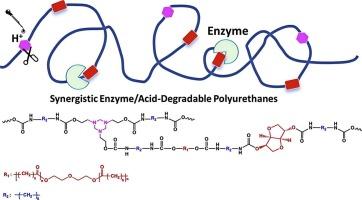具有增强生物相容性和形状记忆性能的协同酶/酸可降解聚氯乙烯基聚氨酯
IF 6.3
2区 化学
Q1 POLYMER SCIENCE
引用次数: 0
摘要
针对传统聚氨酯(PU)面临的不可再生资源依赖、回收困难和功能化需求等挑战,本研究设计了一种具有生物相容性和形状记忆行为的酶和酸协同可降解PU材料。将可酸水解的六氢三嗪(HT)单元和生物基异山梨酯(ISO)加入聚己内酯(PCL)基PU链中,合成了双降解交联的PCL-PU膜。通过调节ISO单元和HT扩链剂的比例,PCL-PU薄膜表现出优异的力学性能,拉伸强度为~ 31.1 MPa,断裂伸长率为~ 963%,同时保持了较高的热稳定性。由于其独特的化学结构,PCL-PU薄膜在酸性和酶促环境中都表现出优异的协同降解性能。具体来说,它们在室温下的磷酸/乙醇溶液中实现了快速和完全的分解,同时表现出部分酶降解(在脂肪酶溶液中6周后重量减轻约28.7%)。此外,PCL-PU薄膜还表现出良好的生物相容性,并具有形状记忆功能,可以在37°C以上自动恢复到原始形状。本研究不仅为PU材料的可持续发展提供了新的方向,也为医用材料、柔性传感器、智能可穿戴设备、自适应结构、环境友好型生物医学应用奠定了基础。本文章由计算机程序翻译,如有差异,请以英文原文为准。

Synergistic enzyme/acid-degradable PCL-based polyurethanes with enhanced biocompatibility and shape memory properties
Addressing conventional polyurethane (PU) challenges including non-renewable resource reliance, recycling difficulties, and demands for functionalization, this study designed an enzymatic and acidic-synergistically degradable PU material with biocompatibility and shape-memory behavior. By incorporating acid-hydrolyzable hexahydrotriazine (HT) units and bio-based isosorbide (ISO) into polycaprolactone (PCL)-based PU chains, crosslinked PCL-PU films with dual degradability were synthesized. By regulating the ratio of ISO units and HT chain extender, the PCL-PU films exhibited superior mechanical properties, with a tensile strength of ∼31.1 MPa and elongation at break of ∼963 %, while maintaining high thermal stability. Thanks to their unique chemical structure, PCL-PU films exhibited superior synergistic degradation properties in both acidic and enzymatic environments. Specifically, they achieved rapid and full breakdown in a phosphoric acid/ethanol solution at room temperature, while exhibiting partial enzymatic degradation (∼28.7 % weight loss after 6 weeks in lipase solution). Furthermore, the PCL-PU films also demonstrated good biocompatibility, and possessed shape-memory functionality, enabling spontaneous recovery to their original shape above 37 °C. This study not only provides a new direction for the sustainable development of PU materials but also lays the foundation for medical materials, flexible sensors, smart wearable devices, adaptive structures, and environmentally friendly biomedical applications.
求助全文
通过发布文献求助,成功后即可免费获取论文全文。
去求助
来源期刊

European Polymer Journal
化学-高分子科学
CiteScore
9.90
自引率
10.00%
发文量
691
审稿时长
23 days
期刊介绍:
European Polymer Journal is dedicated to publishing work on fundamental and applied polymer chemistry and macromolecular materials. The journal covers all aspects of polymer synthesis, including polymerization mechanisms and chemical functional transformations, with a focus on novel polymers and the relationships between molecular structure and polymer properties. In addition, we welcome submissions on bio-based or renewable polymers, stimuli-responsive systems and polymer bio-hybrids. European Polymer Journal also publishes research on the biomedical application of polymers, including drug delivery and regenerative medicine. The main scope is covered but not limited to the following core research areas:
Polymer synthesis and functionalization
• Novel synthetic routes for polymerization, functional modification, controlled/living polymerization and precision polymers.
Stimuli-responsive polymers
• Including shape memory and self-healing polymers.
Supramolecular polymers and self-assembly
• Molecular recognition and higher order polymer structures.
Renewable and sustainable polymers
• Bio-based, biodegradable and anti-microbial polymers and polymeric bio-nanocomposites.
Polymers at interfaces and surfaces
• Chemistry and engineering of surfaces with biological relevance, including patterning, antifouling polymers and polymers for membrane applications.
Biomedical applications and nanomedicine
• Polymers for regenerative medicine, drug delivery molecular release and gene therapy
The scope of European Polymer Journal no longer includes Polymer Physics.
 求助内容:
求助内容: 应助结果提醒方式:
应助结果提醒方式:


